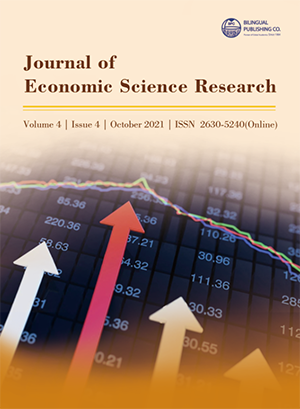The Impact of Money Supply on the Economy: A Panel Study on Selected Countries
DOI:
https://doi.org/10.30564/jesr.v4i4.3782Abstract
This study investigates the impact of money supply on economic growth rate, inflation rate, exchange rate and real interest rate. We used a panel of 217 countries from 1960 to 2020 and four different models to address these questions. The empirical results support the quantity theory of money. In addition, the study found evidence for a negative relationship between real interest rate and inflation and between money supply and real interest rate. Finally, our results show that lagged money growth rate is positively correlated with GDP growth rate but money growth rate is negatively correlated with GDP growth rate.
Keywords:
Money supply, Economic growth, Inflation, Real interest rate, Real exchange rateReferences
[1] Adetunji. M and Isa.M (2011), “Money Supply, Inflation and Economic Growth in Nigeria” Asian-African Journal of Economics and Econometrics, Vol 11, No 1, pp 221-237.
[2] Chaitip. P et al. (2015), “Money Supply Influencing on Economic Growth-Wide Phenomena of AEC Open Region” International Conference of Applied Economics, Vol 24, pp. 108-115.
[3] De Grauwe. P and Polan. M (2005), “Is Inflation Always and Everywhere a Monetary Phenomenon?” Scand. J. of Economics, Vol 107(2), pp. 239-259.
[4] Drabicki. J and Takayama.A (1984), “The Stability of a Neoclassical Monetary Growth Model” The Economic Studies Quarterly, Vol 35, No 3.
[5] Dwyer, G. P. Jr. and Hafer, R. W. (1999), “Are Money Growth and Inflation Still Related?”, Federal Reserve Bank of Atlanta Economic Review 84, 32-43.
[6] Emerson.J (2006), “The Quantity Theory of Money: Evidence from the United States” Economics Bulletin, Vol. 5, No. 2 pp. 1-6.
[7] Fischer. S (1983), “Inflation and Growth” National Bureau of Economic Research, No 1235.
[8] Friedman, B, and Kuttner, K. (1992), “Money, Income, Prices, and Interest Rates.”, The American Economic Review, 82: 472-492.
[9] Herwartz, H., and Reimers H.-E. (2006), “Long-Run Links among Money, Prices and Output: Worldwide Evidence”, German Economic Review, Vol. 7: 65-86.
[10] Jansen, E. (2004), “Modelling Inflation in the Euro Area”, ECB Working Paper no. 322, Frankfurt.
[11] Majid, M. Z. A. (2007), “Causal Link between Money, Output and Prices in Malaysia: An Empirical Re-Examination”, Applied Econometrics and International Development, 7(1).
[12] Miyao, R. (1996) “Does a Cointegrating M2 Demand Relation Really Exist in the United States?”, Journal of Money, Credit, and Banking 28 (3), 365-380.
[13] Moosa, I. A. (1997) “Testing the long-run neutrality of money in a developing economy: The case of India.”, Journal of Developmental Economics 53, 139- 155.
[14] Moazzami, B. and Gupta, K. L. (1996) “The quantity theory of money and its long-run implications.”, Journal of Macroeconomics 17, 667-682.
[15] Owoye O, Onafowora AO. (2007) “M2 Targeting , Money Demand and Real GDP Growth in Nigeria: Do Rules Apply?” Journal of Business and Public Affair, 1(2): 25-34.
[16] Ramachandra, V. S. (1986) “Direction of Causality between Monetary and Real Variables in India-An Extended Result.”, Indian Economic Journal, 34: 98- 102.
[17] Sims C.A. (1992). “Money Income, Causality”, American Economic Review, 62: 540 -542.
[18] Whitesell, W. (1997) “Interest Rates and M2 in an Error Correction Macro Model.” Finance and Economics Discussion Series 59, Washington: Board of Governors of the Federal Reserve System.
[19] Wooldridge, J. M., (2019). Introductory Econometrics: A Modern Approach, 7th Edition, Mason, Ohio: South-Western Cengage Learning.
Downloads
Issue
Article Type
License
Copyright and Licensing
The authors shall retain the copyright of their work but allow the Publisher to publish, copy, distribute, and convey the work.
Journal of Economic Science Research publishes accepted manuscripts under Creative Commons Attribution-NonCommercial 4.0 International License (CC BY-NC 4.0). Authors who submit their papers for publication by Journal of Economic Science Research agree to have the CC BY-NC 4.0 license applied to their work, and that anyone is allowed to reuse the article or part of it free of charge for non-commercial use. As long as you follow the license terms and original source is properly cited, anyone may copy, redistribute the material in any medium or format, remix, transform, and build upon the material.
License Policy for Reuse of Third-Party Materials
If a manuscript submitted to the journal contains the materials which are held in copyright by a third-party, authors are responsible for obtaining permissions from the copyright holder to reuse or republish any previously published figures, illustrations, charts, tables, photographs, and text excerpts, etc. When submitting a manuscript, official written proof of permission must be provided and clearly stated in the cover letter.
The editorial office of the journal has the right to reject/retract articles that reuse third-party materials without permission.
Journal Policies on Data Sharing
We encourage authors to share articles published in our journal to other data platforms, but only if it is noted that it has been published in this journal.




 Javier de Oña García Matres
Javier de Oña García Matres

